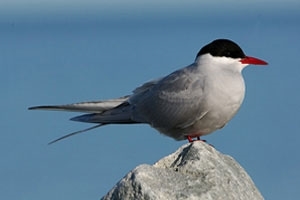Arctic tern (Sterna paradisaea)
 Travel agents will tell you that around the shortest day of the year (21 or 22 December) our minds start to think of summer holidays and long days of blue, sunshine-filled skies. It was thoughts along these lines that led me to contemplate the delicate little Arctic tern, the species that probably sees more sunlight than any other in the whole world!
Travel agents will tell you that around the shortest day of the year (21 or 22 December) our minds start to think of summer holidays and long days of blue, sunshine-filled skies. It was thoughts along these lines that led me to contemplate the delicate little Arctic tern, the species that probably sees more sunlight than any other in the whole world!
The Arctic tern is a truly remarkable bird. Weighing only around 3 ½ ounces (100g) and with a wingspan of just over 31 inches (80cm), it migrates some 44,000 miles (71,000km) to the Antarctic annually. The oldest Arctic tern so far recorded lived for 34 years, which meant that in its lifetime it travelled nearly 1.5 million miles (2.4 million kilometres) – equivalent to three return trips to the moon!
The Arctic tern is a handsome white bird with a black cap and red bill and legs. It also has long, elegant tail streamers, which gives rise to its other commonly used name of “sea swallow”. We have about 53,000 pairs nesting in the UK, mainly on the Farne Islands off the coast of Northumberland and on the Northern Isles. But it is work by a research team based in Greenland that has really begun to shed light on exactly where these amazing birds go on migration.
Tiny radio tracking devices fitted to the birds quickly revealed that they don’t fly straight to the Antarctic, but in fact stop for around 25 days in an area about 600 miles north of the Azores. This region is the junction between cold, highly productive northern waters and the warmer but less productive southern waters. During this time they build up their body weight by gorging themselves on the plentiful zooplankton and small fish that abound in these plentiful seas, before embarking on their long journey south, crossing water that is poorly stocked by comparison.
The terns then head off south down the African coastline, but on reaching the Cape Verde islands, about half split away and cross the Atlantic to continue their journey along the Brazilian coastline, leaving the others to track on down the African coast. Although it is not clear why this happens, it is believed that winds may appear to make either of the routes more favourable to the terns. Eventually, after around three months of travelling, they arrive in the Weddell Sea on the shores of Antarctica were they will spend the next four to five months.
The radio tracking research has shown that the trip back north bears little resemblance to the southerly journey, but instead takes a colossal “S” shape journey up the middle of the Atlantic Ocean. Although they make a detour of hundreds of miles, the route they follow corresponds well with the prevailing global wind systems, being anticlockwise in the South Atlantic, but clockwise in the North Atlantic. The decision to follow the winds obviously works, as the birds only take around 40 days to make the journey back to Greenland!
So, if you are pining for some sun on your back as you read this, perhaps you should contemplate putting in your bid to be reincarnated as an Arctic tern in the next life!
Peter Thompson
Advisory

Download Peter Thompson's essential 26-page book, featuring beautiful photography and detailed profiles of Britain's wildlife
Download FREE >